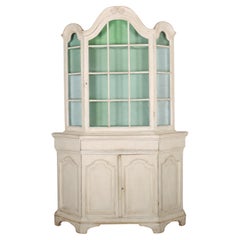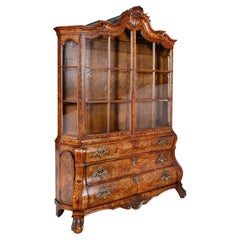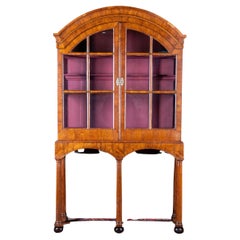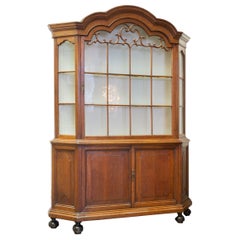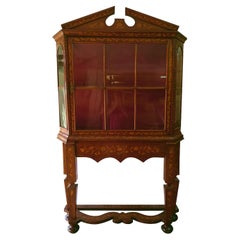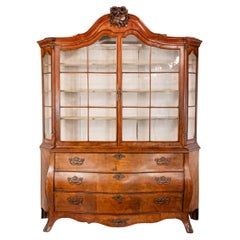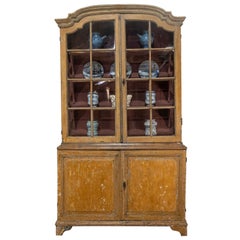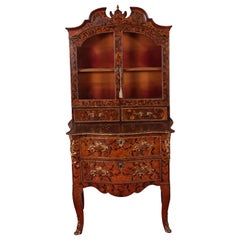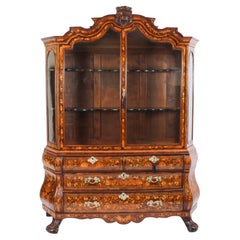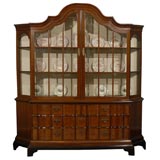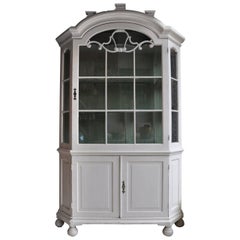18th Century Dutch Vitrine
Antique 18th Century Dutch Vitrines
Glass, Pine
Antique Mid-18th Century Dutch Vitrines
Boxwood, Walnut
Antique Early 18th Century Dutch Vitrines
Walnut
Antique Early 1800s English Rococo Vitrines
Brass
Antique Early 18th Century Dutch Dutch Colonial Vitrines
Oak
Antique 18th Century Dutch Vitrines
Wood
Antique Late 18th Century Dutch Rococo Vitrines
Bronze
Antique 18th Century Danish Cabinets
Wood, Walnut
Antique Early 18th Century Dutch Rococo Commodes and Chests of Drawers
Walnut
Antique Late 18th Century Dutch Louis XIV Bookcases
Brass
Antique 1770s Dutch Baroque Cabinets
Mahogany
Antique 1780s Cabinets
Walnut
Antique Late 18th Century Dutch Dutch Colonial Cupboards
Brass
Recent Sales
Antique 18th Century and Earlier Dutch Vitrines
Antique Mid-18th Century Dutch William IV Vitrines
Antique 1750s Dutch Louis XV Vitrines
Glass, Oak
Antique Early 18th Century Dutch Louis XIV Vitrines
Walnut
Antique 18th Century and Earlier Dutch Vitrines
Mahogany, Fruitwood
Antique Late 18th Century Dutch Bookcases
Oak
Antique 17th Century Dutch Vitrines
Oak
Antique 18th Century and Earlier Dutch Vitrines
Antique 18th Century and Earlier Vitrines
Oak
Antique 18th Century Dutch Vitrines
Wood
Antique 18th Century European Rococo Vitrines
Wood, Paint
Antique 18th Century Dutch Vitrines
Oak
Antique 18th Century and Earlier Dutch Vitrines
Oak
Antique 18th Century Dutch Baroque Vitrines
Antique 18th Century Unknown Other Vitrines
Wood
Antique 18th Century and Earlier Dutch Vitrines
Antique Late 18th Century Dutch Rococo Vitrines
Mahogany, Paint, Satinwood, Glass, Kingwood
Antique 18th Century Dutch Cabinets
Walnut
Antique Late 18th Century Dutch Vitrines
Blown Glass, Oak
Antique Mid-18th Century Dutch Baroque Vitrines
Oak
Antique Late 18th Century Dutch Vitrines
Antique 18th Century and Earlier Dutch Vitrines
Mahogany
Antique 18th Century and Earlier Dutch Rococo Vitrines
Walnut
Antique 18th Century Dutch Renaissance Vitrines
Glass, Oak
Antique 18th Century and Earlier Dutch Vitrines
Walnut
Antique Mid-18th Century Dutch Baroque Vitrines
Glass, Wood
Antique 18th Century and Earlier Dutch Vitrines
Walnut
Antique 18th Century Dutch George III Vitrines
Glass, Walnut
Antique 18th Century and Earlier Dutch Vitrines
Antique 18th Century and Earlier Dutch Vitrines
Mahogany, Glass
Antique Late 18th Century Dutch Regency Vitrines
Walnut
Antique 18th Century and Earlier Dutch Bookcases
Antique 1760s Dutch Louis XV Secretaires
Walnut
People Also Browsed
Antique Late 18th Century Swedish Rococo Cabinets
Bronze
Antique 19th Century Austrian Bookcases
Glass, Pine
Antique 19th Century Dutch Queen Anne Cabinets
Walnut, Glass
Early 20th Century American Georgian Bookcases
Glass, Boxwood, Mahogany
Antique 1760s English George III Dressers
Mahogany
Antique 19th Century Dutch Baroque Commodes and Chests of Drawers
Brass
Early 20th Century Italian Art Deco Vitrines
Walnut
Antique Early 19th Century Dutch Rococo Cabinets
Brass
Antique 1820s English George III Cabinets
Brass
Antique 1890s English Vitrines
Pine
Antique 19th Century English William IV Bookcases
Oak, Pine
Antique 18th Century Swedish Cupboards
Pine
Antique Late 19th Century English Chippendale Bookcases
Glass, Mahogany
Mid-20th Century Bookcases
Pine
Antique Early 19th Century French Louis XVI Desks
Brass
Antique 1880s British Bookcases
Mahogany
18th Century Dutch Vitrine For Sale on 1stDibs
How Much is a 18th Century Dutch Vitrine?
Finding the Right Vitrines for You
Why not give your precious collectibles the case pieces they deserve? Antique and vintage vitrines can be used to safely store and display your most treasured objects.
While they were initially used to display relics in churches or to preserve specimens for scientific observation, vitrines are best known for their place in retail spaces and museums. The name for these glass display cases comes from the Latin word “vitrum,” meaning glass, as well as the Old French word “vitre,” which also refers to glass. Instead of simply showcasing collector’s items on shelves, you can bestow extra importance on them by displaying them in a vitrine for passers-by to observe and admire.
Not all vitrines are created equal. Over time, furniture makers have explored different shapes and sizes for vitrines. A display case you’ll find in a retail store will likely look drastically different from what you’ll see in a museum or art gallery. A vitrine in a shop is likely there to best market specific wares to the general public, while in museums there is usually a range of different vitrines intended to house and protect single objects or to display a grouping of artifacts.
Most of us have an antique, new or vintage case piece in our home. Though the terms “case pieces” and “case goods” may cause even the most decor-obsessed to stumble, these furnishings have been a vital part of the home for centuries. Any furnishing that is unupholstered and has some semblance of a storage component — cabinets, dressers, buffets — may be properly termed a case piece.
Mirror-backed vitrines, which refer to cases that usually feature shelved and mirrored interiors, are a most appropriate home for your jewelry or decorative objects. Adding such items to a vitrine already suggests that there is an irreplaceable preciousness to the case’s contents, and the mirrors will emphasize as much as well as refract more light to render the display eye-catching.
On 1stDibs, find a wide variety of antique and vintage vitrines to protect and preserve your most prized items. The collection of mid-century modern vitrines and Art Deco vitrines is mostly inclusive of those built with a wooden frame, but there are many other types to choose from as well. It’s time to give your collectibles a good home!
- 1stDibs ExpertNovember 13, 2024To identify 18th-century furniture, you can research your piece in the context of the prevailing styles of the period or consult a certified appraiser or experienced antique dealer. To identify your item on your own, look over it for maker's marks, such as carvings, stamps, brands and labels. Researching the marking can help you determine the maker of your piece, and from there, you can search further to learn more about your particular item. Without a maker's mark, the best approach is to consider the characteristics of the dominant furniture styles during the 18th century. In England, these included William and Mary, Queen Anne, Georgian, Chippendale, Hepplewhite and Sheraton. Some French furniture styles of the 1700s include Louis XV, Louis XVI and Régence. Find a diverse assortment of 18th-century furniture on 1stDibs.
- 1stDibs ExpertApril 5, 2022Yes, wedding rings have a long history, stretching back to ancient Egypt. The first diamond engagement ring was created in 1477 by Archduke Maximillian of Austria. Browse a wide array of vintage and contemporary wedding rings on 1stDibs.
- 1stDibs ExpertApril 5, 2022In the 18th century, art changed in style from Baroque to Rococo and Neoclassicism. Art became more ornamented and idealized during the Rococo period and then shifted toward a style that emulated the artwork of ancient Greece and Rome near the end of the century. You’ll find a variety of fine art on 1stDibs.
- 1stDibs ExpertApril 5, 202217th-century Dutch portraiture has many similarities to other Baroque paintings, including rich colors, dark shadows and intense lighting. Many famous Dutch Baroque works lean toward realism. In Dutch portraiture, props and detailed backgrounds are uncommon. You'll find a collection of Dutch Baroque paintings from some of the world’s top art dealers on 1stDibs.
- 1stDibs ExpertApril 5, 2022One way to check if your brass candlesticks are from the 18th century is to look for the two seams running lengthwise on either side. This is from when the candlestick was molded in two halves and then soldered together. You’ll find a variety of candlesticks of all shapes and sizes from some of the top sellers on 1stDibs.
- 1stDibs ExpertJanuary 10, 2025The individuals considered the Big Three of 18th-century cartoons are William Hogarth, James Gillray and George Cruikshank. Although the 18th century saw a widespread increase in illustrations in newspapers, these three illustrators were particularly well-known for their work. Hogarth's work was extremely diverse, ranging from serious, realistic paintings and portraits to satirical and moralistic illustrations filled with symbolism. A British caricaturist, Gillray is remembered today for his artworks representing political and social satires, like his political cartoons against George III of England. Despite being a prolific caricaturist, Cruikshank is now most famous for illustrating the works of Charles Dickens. On 1stDibs, find a wide variety of illustrations.
- 1stDibs ExpertApril 5, 2022At the end of the 17th century, Europe went into a frenzy over porcelain. Asian porcelain was highly sought after, and spurred the foundation of the Meissen factory in France, where hard porcelain went on to be made. You’ll find a large collection of porcelain pieces from many of the world’s top sellers on 1stDibs.
Read More
The Ultimate Guide to Types of Tables for the Home
Whether you’re just moving in or ready to give your home a makeover, our guide will give you pointers on tables that are fitting for every room, nook and hallway.
What Exactly Is a Secretary Desk, and What Is It Used For?
The furniture equivalent of a Swiss Army knife, it's the multifunctional piece you didn't know you needed.
This Shelving System with Oxidized Brass Tubes Is Retro and Futuristic at Once
Italian studio DimoreMilano mustered great ingenuity when crafting these sculptural shelves, which are built without any screws.
28 Cheerful Home Bars, Where Everybody (Literally) Knows Your Name
Simple or sophisticated, equipped with console, cart or custom cabinetry, these stylish bar areas deserve a toast.
Ask an Interior Designer: Work-from-Home Edition
Leaping into a design project, whether it's refreshing the bedroom or redoing the whole house, can be overwhelming. Luckily, we know more than a few interior designers. You asked questions on Instagram, and now they're answering.
Collected and Eclectic, ‘Wunderkammern’ Are Back in a Big Way
Introduced nearly 500 years ago, curiosity cabinets are finding new fans among today's collectors and designers.
Meet the Incredible Woman Transforming Fallen Trees into Sleek Furniture
In the hands of New York Heartwoods cofounder Megan Offner, unwanted local trees become works of design art.
These New York Architects Love a Complicated Project
From Brooklyn townhouses to Maine campgrounds, Trattie Davies and Jonathan Toews relish a challenge, like transforming a former warehouse space into the new 1stdibs Gallery.
